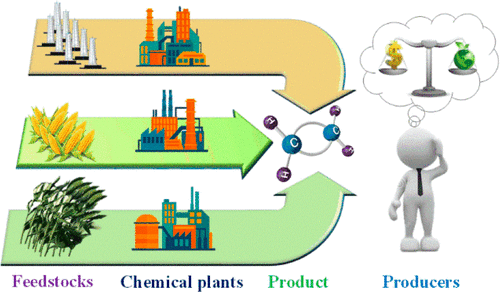当前位置:
X-MOL 学术
›
Ind. Eng. Chem. Res.
›
论文详情
Our official English website, www.x-mol.net, welcomes your feedback! (Note: you will need to create a separate account there.)
Manufacturing Ethylene from Wet Shale Gas and Biomass: Comparative Technoeconomic Analysis and Environmental Life Cycle Assessment
Industrial & Engineering Chemistry Research ( IF 4.2 ) Pub Date : 2018-01-24 00:00:00 , DOI: 10.1021/acs.iecr.7b03731 Minbo Yang 1 , Xueyu Tian 1 , Fengqi You 1
Industrial & Engineering Chemistry Research ( IF 4.2 ) Pub Date : 2018-01-24 00:00:00 , DOI: 10.1021/acs.iecr.7b03731 Minbo Yang 1 , Xueyu Tian 1 , Fengqi You 1
Affiliation

|
This paper presents comparative technoeconomic and environmental analyses of three ethylene manufacturing pathways based on ethane-rich shale gas, corn stover, and corn grain. The shale-gas-based pathway includes two processing steps, namely, shale gas processing to produce ethane and ethane steam cracking to manufacture ethylene. The two biomass-based pathways also contain two processing steps each, namely, bioethanol production via fermentation and ethylene manufacturing via bioethanol dehydration. A distributed–centralized processing network that consists of distributed ethane/bioethanol production and centralized ethylene manufacturing is employed for each of the three pathways. Detailed process simulation models are developed for major processing steps, and the three pathways are then modeled on five different ethylene production scales. On the basis of the detailed mass and energy balances and life cycle inventory results, we conduct technoeconomic and life cycle analyses to systematically compare the economic and environmental performances of the three ethylene manufacturing pathways. The results indicate that the shale-gas-based pathway is the most attractive due to the lowest break even ethylene prices ($0.32/kg to $1.67/kg); however, it leads to the highest greenhouse gas emissions of about 1.4 kg CO2-equiv/kg ethylene. On the contrary, the corn-stover-based pathway results in the lowest greenhouse gas emissions of around −1.0 kg CO2-equiv/kg ethylene but the highest break even ethylene prices ($2.0/kg to $4.1/kg). Sensitivity analyses are performed to systematically investigate the influences of parameter deviations on the economic and environmental performances of the three ethylene manufacturing pathways.
中文翻译:

从湿页岩气和生物质生产乙烯:比较技术经济分析和环境生命周期评估
本文介绍了基于富含乙烷的页岩气,玉米秸秆和玉米籽粒的三种乙烯生产途径的比较技术经济和环境分析。基于页岩气的途径包括两个处理步骤,即,用于产生乙烷的页岩气处理和用于制造乙烯的乙烷蒸汽裂化。这两个基于生物质的途径还分别包含两个处理步骤,即通过发酵生产生物乙醇和通过生物乙醇脱水生产乙烯。这三种途径中的每一种都采用了由分散的乙烷/生物乙醇生产和集中的乙烯生产组成的分布式集中处理网络。针对主要的加工步骤开发了详细的过程模拟模型,然后在五个不同的乙烯生产规模上对三个路径进行了建模。在详细的质量和能量平衡以及生命周期清单结果的基础上,我们进行技术经济和生命周期分析,以系统比较三种乙烯生产途径的经济和环境绩效。结果表明,基于页岩气的途径最具吸引力,因为乙烯的收支平衡价最低(0.32美元/千克至1.67美元/千克)。但是,这导致最高的温室气体排放量约为1.4千克二氧化碳 32 /公斤至$ 1.67 /公斤);但是,这导致最高的温室气体排放量约为1.4千克二氧化碳 32 /公斤至$ 1.67 /公斤);但是,这导致最高的温室气体排放量约为1.4千克二氧化碳2当量/ kg乙烯。相反,基于玉米秸秆的途径导致最低的温室气体排放量约为-1.0 kg CO 2当量/ kg乙烯,但最高的盈亏平衡乙烯价格($ 2.0 / kg至$ 4.1 / kg)。进行敏感性分析以系统地研究参数偏差对三种乙烯生产途径的经济和环境绩效的影响。
更新日期:2018-01-24
中文翻译:

从湿页岩气和生物质生产乙烯:比较技术经济分析和环境生命周期评估
本文介绍了基于富含乙烷的页岩气,玉米秸秆和玉米籽粒的三种乙烯生产途径的比较技术经济和环境分析。基于页岩气的途径包括两个处理步骤,即,用于产生乙烷的页岩气处理和用于制造乙烯的乙烷蒸汽裂化。这两个基于生物质的途径还分别包含两个处理步骤,即通过发酵生产生物乙醇和通过生物乙醇脱水生产乙烯。这三种途径中的每一种都采用了由分散的乙烷/生物乙醇生产和集中的乙烯生产组成的分布式集中处理网络。针对主要的加工步骤开发了详细的过程模拟模型,然后在五个不同的乙烯生产规模上对三个路径进行了建模。在详细的质量和能量平衡以及生命周期清单结果的基础上,我们进行技术经济和生命周期分析,以系统比较三种乙烯生产途径的经济和环境绩效。结果表明,基于页岩气的途径最具吸引力,因为乙烯的收支平衡价最低(0.32美元/千克至1.67美元/千克)。但是,这导致最高的温室气体排放量约为1.4千克二氧化碳 32 /公斤至$ 1.67 /公斤);但是,这导致最高的温室气体排放量约为1.4千克二氧化碳 32 /公斤至$ 1.67 /公斤);但是,这导致最高的温室气体排放量约为1.4千克二氧化碳2当量/ kg乙烯。相反,基于玉米秸秆的途径导致最低的温室气体排放量约为-1.0 kg CO 2当量/ kg乙烯,但最高的盈亏平衡乙烯价格($ 2.0 / kg至$ 4.1 / kg)。进行敏感性分析以系统地研究参数偏差对三种乙烯生产途径的经济和环境绩效的影响。



























 京公网安备 11010802027423号
京公网安备 11010802027423号